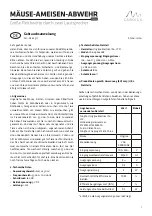
Installation and Service Manual
Installation
Reverse Latch Assembly
The latch locks the reverse duct in any position. The reverse duct can be moved by the hand controller from
inside the vessel, but cannot be moved by forcing the reverse duct itself. The latch has been factory adjusted
and tested and should not require adjustment during installation.
Reverse Cable
Cable controls should be installed with the minimum number of bends, each with as large a radius as
possible. A four inch stroke reverse cable will be required. Suitable cable is Morse 64C or an equivalent.
The cable is required to have a cable clamp at the jet unit end of the cable.
The jet unit, as supplied, has the cable leaving the latch towards the right hand side of the vessel for a right
hand drive. The cable runs up the right side of the vessel to the hand controller at the driver's right hand
side.
If the vessel is left hand drive, the cable should leave the latch towards the left hand side of the vessel. This
can be done by using the left hand drive cable bracket kit (spares assembly [B]) which can be obtained from
CWF Hamilton. The cable will then run to a hand controller at the driver's left hand side.
The cable must be allowed to move up and down 40mm or so with the brake rod [41], as
shown in the drawing. For this reason the cable outer should not be anchored too close to
the reverse latch; a distance of greater than 750mm is recommended.
Use the following procedure to install:
Follow the manufacturer's instructions when setting up push / pull cable lines.
When installing the hand controller, note the control lever must "push" the cable when moving the
control lever ahead (for ahead thrust).
Install the cable, connect to the hand controller but not to the jet unit.
With the cable fitted in place, but disconnected at the jet end, operate the control lever from full stroke
to full stroke. Check for freedom of movement.
Mount the cable outer with the cable anchored to the cable mount [20]. Use Loctite on the screws and
make sure they are tight; failures have occurred with these cable anchors coming loose.
Connect the cable to the latch chassis [29]. Install the rubber washers [44] as shown. This allows the latch
chassis [29] to align itself with the brake rod [41]. Failure to include these washers [44] may allow the
latch to become stiff to operate.
Adjust the position of the nuts [48] so that when the controller is in the full ahead position, the reverse
duct [1] stops hard against the reverse duct bump stop [30].
It is preferable to have the reverse duct hard against the bump stop in the full ahead
position, as this allows the latch system to lock with some tension on the linkages, which
prevents movement and rattling of the reverse duct and linkages during trailering.
Move the controller to the full reverse position and check that the lip of the reverse duct [1] is below the jet
outlet from the nozzle.
Adjust any stops on the controller to limit the cable stroke as required.
In full reverse position the crank pin [21] should be directly above the reverse shaft [8].
With 4inches of cable stroke, the crank [11] should move through 90deg.
5-11
Summary of Contents for HJ212
Page 1: ...HJ212 Installation and Service Manual R3A3 Jet unit Manual ...
Page 20: ...Product Description Installation and Service Manual 2 6 ...
Page 56: ...Commissioning Installation and Service Manual 6 4 ...
Page 62: ...Fault Finding Installation and Service Manual 7 6 ...
Page 82: ...Maintenance Installation and Service Manual 8 20 ...
Page 137: ...Installation and Service Manual Appendix Notes 10 21 ...
Page 141: ...Installation and Service Manual Appendix Notes 10 25 ...
Page 164: ...Appendix Installation and Service Manual 10 48 ...
Page 166: ......
Page 169: ......
Page 171: ......
Page 172: ......
Page 175: ......
Page 176: ......
Page 177: ......
Page 178: ......
Page 181: ......
Page 185: ......
Page 186: ......
Page 188: ......
Page 195: ......
Page 196: ......
Page 197: ...Notes ...
















































